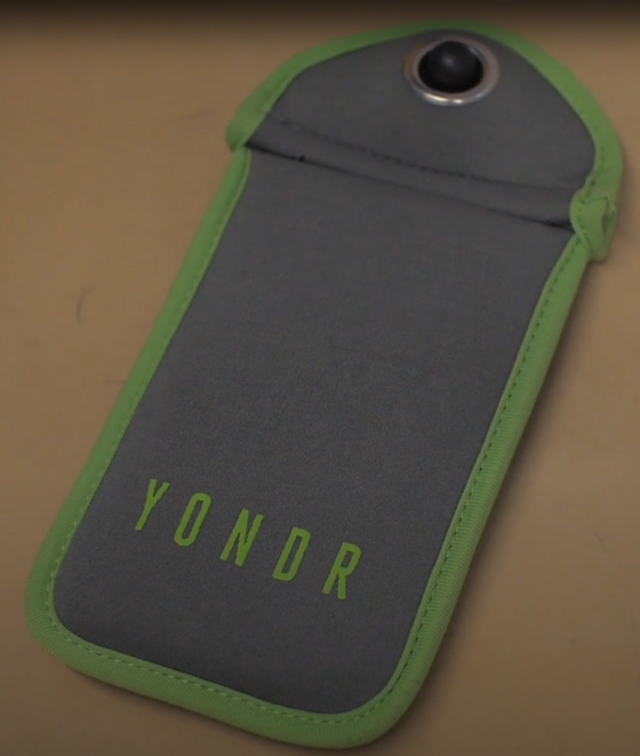
THE MIRROR | Courtesy of Ted Everett on Wikimedia Commons
Students disregard Yondr pouches despite the school’s policy.
In a school district where classrooms overflow, facilities crumble and some teachers work second jobs to make ends meet, LAUSD somehow found $7 million for magnetic neoprene pouches.
Not for school supplies, updated technology or salary raises. For phone pouches. Yondr pouches, to be exact — the district’s newest attempt at enforcing digital abstinence in the classroom.
And it didn’t take long for students to reduce this initiative to what it always was: a performative, duct-tape solution to a much deeper structural issue.
Here at Van Nuys High School, it only took a few days for students to find ways around the Yondr pouches, a development that echoed throughout most of the district.
From smuggling in decoy phones to ordering magnets off Amazon, teenagers have thoroughly dismantled the fantasy that you can out-engineer an addiction with Velcro and good intentions.
Let’s give credit where it’s due. LAUSD made a bold, even if costly, move to improve focus in classrooms.
Aiming to restrict phone usage wasn’t completely misguided, as data suggests it can improve academic performance.
A 2023 report from UNESCO identified phones as a significant disruption in classrooms, hinting at the benefits of a phone ban. Further, a study published by ScienceDirect found that banning phones would equate to an extra hour of instructional time per week.
But the problem is that results only follow if the policy is enforceable. This one isn’t.
Administrators barely made it a month before giving up the fight. Teachers stopped checking pouches. Staff patrolling the campus stopped caring. As it became increasingly clear that students couldn’t be trusted or effectively monitored, enforcement fizzled away.
Today, students openly scroll through TikTok in hallways and text in class. Every student still has a Yondr pouch, sure. But most have never been touched, and many simply get left at home.
Let that sink in: a multimillion-dollar solution to phone distraction fell apart in weeks. The most good that came out of the Yondr pouches was an excellent case study in why district-level decisions made in a vacuum almost always backfire.
What LAUSD failed to anticipate is that locking a teenager’s lifeline in a fancy oven mitt would provoke defiance, not discipline.
According to a 2024 Pew Research Center study, 95% of teens have smartphones, and nearly half say they are online “almost constantly.”
Clearly, this isn’t just a distraction issue; it’s a full-blown dependency. To slap a magnet on that dependency and call it a solution requires an astonishing lack of foresight.
A phone pouch, no matter how well-designed, would never have overridden the fact that students don’t want to be disconnected.
Within weeks of the policy’s implementation, online tutorials surfaced showing how to break into the pouches with magnets. Some students took to smashing them against desks. Once enforcement at school noticeably died down, many disregarded them entirely.
Let’s not pretend this outcome wasn’t inevitable. Any policy that hinges on student integrity, mass compliance and daily administrative policing is doomed from the start.
Resources are already stretched too thin in LAUSD for schools to monitor bathroom graffiti, let alone hundreds and thousands of middle and high school students.
Now we’re left with a pile of green and gray pouches that students laugh at, teachers ignore and administrators have quietly started distancing themselves from.
A policy that promised to transform school culture instead revealed how out of touch district leadership really is.
And that’s $7 million gone — funds that could have gone toward hiring credentialed teachers, expanding mental health resources or, ironically, building better digital literacy programs.
To be clear, the problem isn’t that LAUSD wanted to curb phone use. It’s that they chose the laziest way to do it.
Instead of treating phone dependency as a real, nuanced challenge worthy of curriculum integration and behavioral support, they outsourced the problem to a magnet pouch and called it reform.
There are smarter ways forward.
Designating phone-free classrooms while allowing limited use during passing periods and lunch is one. Teaching digital self-regulation as part of health or advisory curricula is another. Building genuine trust with students instead of policing them like inmates might actually work.
But LAUSD didn’t want nuance. It wanted optics. It wanted headlines. And now, it has them — only not the kind they hoped for.
The question now is whether LAUSD will double down on failure or pivot to something that actually engages students instead of trying to disable them.
Because one thing is clear: a teenager on their phone is no worse than a district pretending it knows how to stop them.
